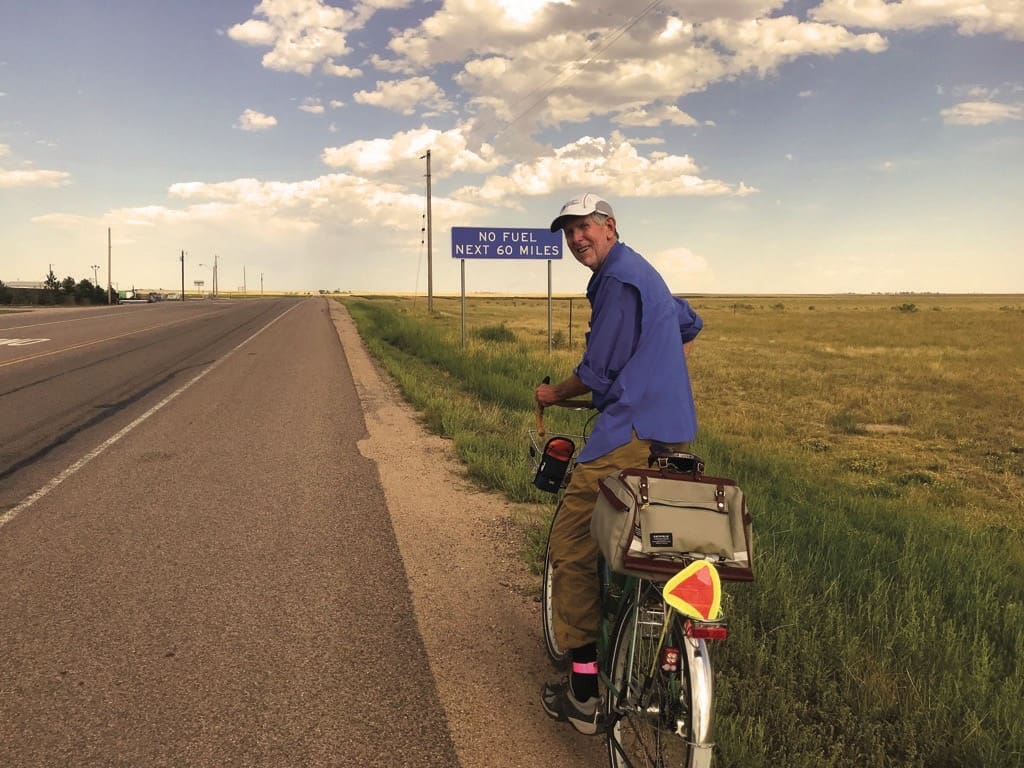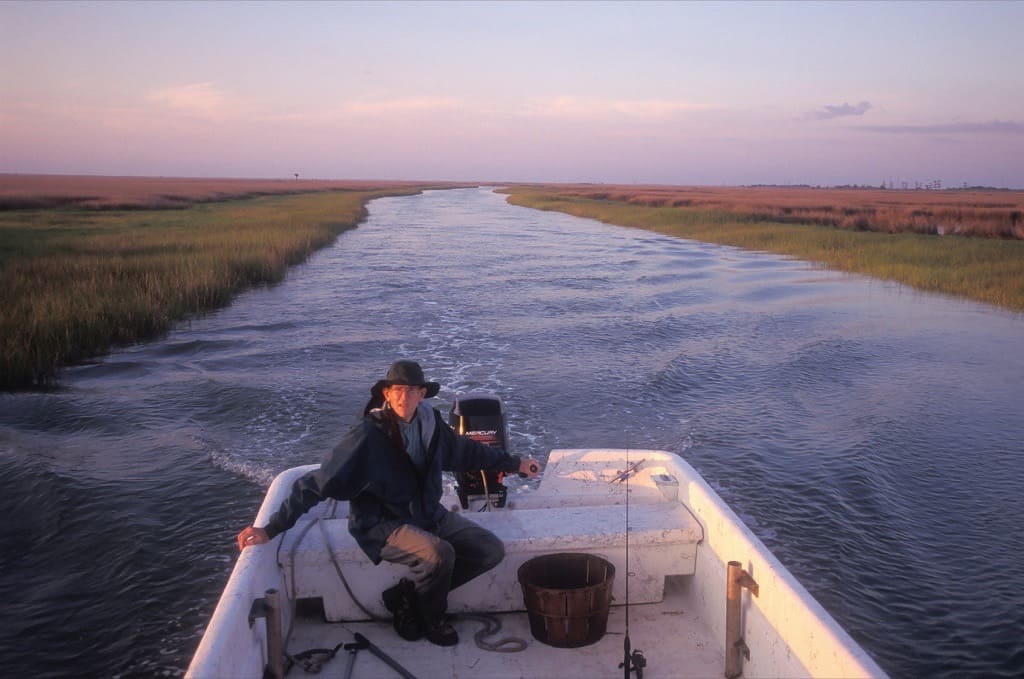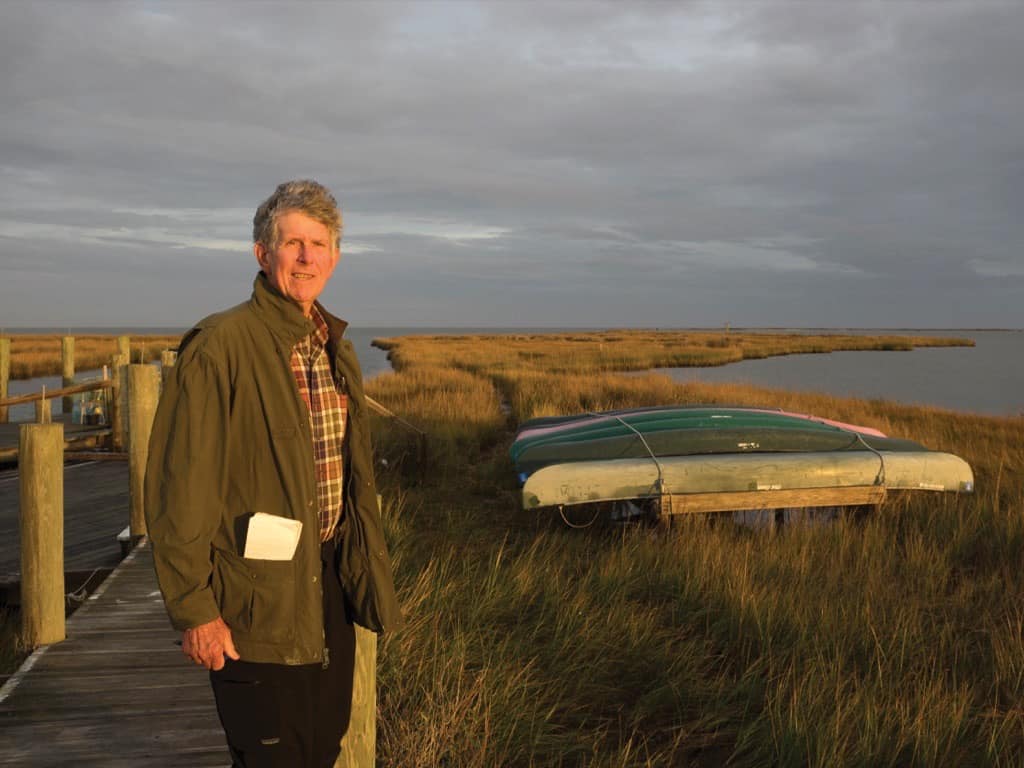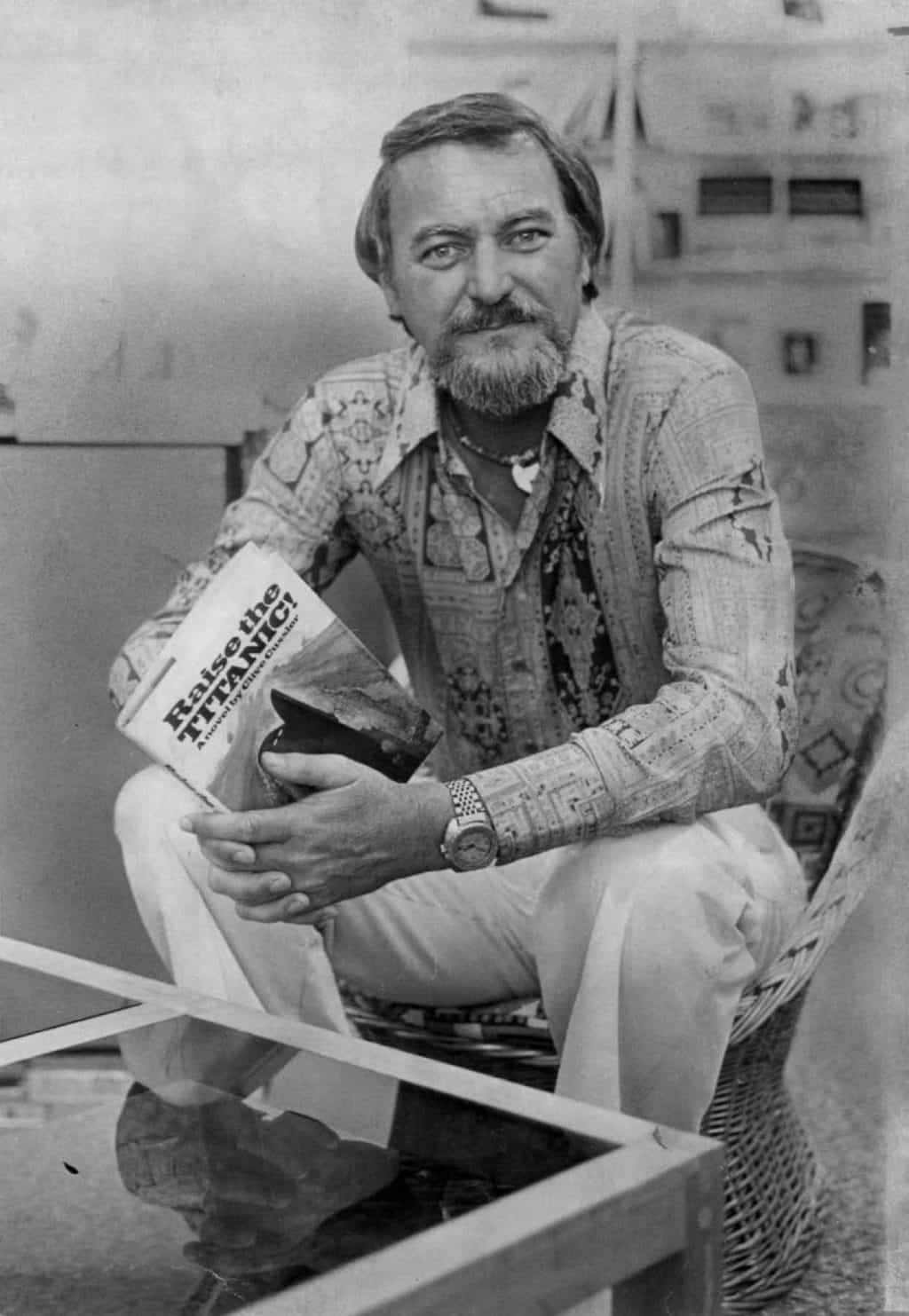Born on the Eastern Shore, Tom Horton chronicles the Bay.
Photos by Dave Harp
The final pump and pedal of Tom Horton’s marathon bike ride of 2019—six weeks through 11 states, from the Western Continental Divide to the Wicomico River and finally up the driveway of his Salisbury home—took place not far from the spot where his grandfather taught him to ride a tricycle.
“Just a couple of hundred yards and 70 years away,” said Horton, a reporter, author and filmmaker who has spent the last five decades explaining the Chesapeake Bay to the rest of the world. “Somehow that was a real good feeling.”
It was a feeling in which many of the threads of his life were braided. At 74, he’d returned to his Eastern Shore birthplace in late September on a blue-green Rivendell Atlantis touring bike with memories of his three-year-old self on a tricycle; a teacher of nature writing at Salisbury University envisioning his kindly “Grandpa,” Thomas Jefferson Caruthers, a dean of education and the school’s acting president during the Great Depression, who showed him how to handle a three-wheeler.
In the near distance at ride’s end stood Grandpa’s old house, 303 West College Avenue, now part of the university’s art department. Knowing that the good feeling that bathed Horton was akin to the meditative nature of the trip itself in which he enjoyed, “a lot of nice sunrises and a lot of quiet.”
Only twice did bicycles not convey Horton and his riding partner—retired prison counselor David A. Schultz, a decade younger than Tom—from there to here.
The first was a 45-minute train ride from Hermann, Missouri to the banks of the Father of Waters in St. Louis, having diverted from their bike route to see friends and the botanical gardens of St. Louie.
“We pedaled across the Mississippi at St. Louis on a wonderful pedestrian/bikes-only bridge that was part of old Route 66,” said Horton, noting that the rivers crossed or followed on the trip included the Wabash, the Missouri, the Ohio, the Youghiogheny, and the Potomac.
“I recall pacing a stick floating down the Missouri at Atchison [Kansas],” said Horton, who took almost no notes on the journey. “It was high water, moving about six mph.”
Approaching the ride’s end at Annapolis, the pair put their bikes on a rack and crossed the Chesapeake by automobile.
On the last day, September 26th, Horton and Schultz “parted company with a rolling handshake” on Maryland Route 54. Schultz headed east to his home in Delmar and Horton turned south into a hot wind to home.
“This was the longest trip by far for both of us,” said Horton, noting that he and Schultz only suffered one flat each, victims of a thorn bush. “Dave was a great companion, unflappable. And he can fix bikes better than me.”
That evening came a feeling different from the one occasioned by memories of a tyke on a tricycle when Truman was in charge.
“It was odd,” said Horton, settling in after the ride of a lifetime, from the Western Continental Divide to the Wicomico River. “I guess I’m back.”
So he hopped on the bike, went out for a beer, and slept well in his own bed.

Huck Finn from Hebron
In a journalism career nearing 50 years, Tom Horton has published eight books of non-fiction, covering subjects
from Smith Island to tundra swans; made a handful of
short films about the great outdoors; and reported from the Amazon rainforests, the coral reefs of Australia, and drought-ravaged Sudan.
Horton’s many accolades include the somewhat amusing title “Admiral of the Chesapeake” awarded by former governor Martin O’Malley in 2015 for “extraordinary commitment to the conservation and restoration” of the Bay. A friend, he said, has collected “two or three of them.”
“What I was really proud of was my Coast Guard captain’s license which I had to get when I went to work for the Chesapeake Bay Foundation and moved to Smith Island” in 1987, said Horton. “That was a bona fide hard test. I didn’t ace it, but I did pretty well.”
Admiral of the Chesapeake?
Huck Finn formerly of Hebron would be more appropriate. And given his many and varied adventures, you would think that Horton might be content just to paddle the rivers of the Shore, mulling over whatever it is that a man who reads English poetry and annual crab harvest reports with equal fascination mulls.
Why did the affable septuagenarian—as good a storyteller in person as he is in print—submit to such a demanding test?
Well …
When George Mallory was asked why he simply had to reach the summit of Mount Everest, the world’s highest mountain and the place that claimed his life, the Englishman is said to have answered: “Because it’s there.”
Willie Sutton was equally succinct when questioned about his passion for robbing banks, quipping, “That’s where the money is.”
And Horton, still trim, hale, and hearty with years of serious cycling and kayaking to his credit and a clear eye for how quickly vibrant friends can be hobbled by age, answered, “You can’t depend on feeling this good forever.”
Horton lost his wife, the former Cheri Morin, a social worker/therapist and the mother of his children, Tyler and Abigail, to cancer in 1997. She was 49.
Their first date was the fall of ‘72, not long after Tropical Storm Agnes tossed the rookie reporter into the deep end of around-the-clock newspaper work.
“I took Cheri out from Hooper’s Island with a bunch of commercial netters who left the dock at 4 a.m.,” said Horton, remembering that the boat came back loaded with striped bass and a tasty, blowfish called Northern Puffer. “Maybe that’s why she waited two years to say ‘yes.’”
The fickle nature of health hit him hard again not long ago with the abrupt death of his friend and former Sun editor John S. Carroll, dead at 73 in 2015 from a fleet, degenerative brain disease. It was Carroll who had coaxed Tom back into the pages of The Sun after Horton left the paper to live with his family on Smith Island in 1987, launching the “On the Bay” column that ran for a dozen years on a handshake.
For the duration of the bike trip—from Walden, Colorado, the “Moose Viewing Capital of the World” to the Shore— Horton felt fine. “The bike and I both held up well,” he said, aside from banging his leg in a shower at the border of Indiana and Ohio.
Whatever aches and pains troubled his 6-feet-5-inch, 190-pound frame were soothed by daily, essential doses of Aleve each morning and some CBD/THC candy at day’s end.
The goody-goody gum-drops, in modest measures recommended by a biologist friend, “generated a pleasant buzz and provided some relaxation when wine wasn’t available,” he said.
Leave it to Tom Horton, a most curious documentarian, to get marijuana advice from a biologist.

Catching Chickens
Thomas Wade Horton was born on June 25, 1945 and grew up in a log cabin—noting that he’s not quite old enough to have been born in one—in the once-bustling Caroline County town of Federalsburg.
“I know very little about my ancestors beyond my grandparents,” said Horton. “I never knew Grandad Horton, who left home when my Dad was young. But he always sent me an interesting Christmas presents like dried jackrabbit ears, great treasures for a boy.”
Tom’s father, Herbert E. Horton (1912-2005), hailed from Ardmore in southeast Oklahoma— growing up picking cotton and shooting squirrels for dinner—and came to Maryland after World War II upon his discharge from the Navy in Virginia Beach.
On the Shore, then in the midst of an early expansion of the poultry industry, Herb decided that raising chickens was a good way to go, having given up on beef before the war after getting stiffed for his labors on a Texas cattle drive near Amarillo during the Depression. The elder Horton raised chickens and also ran processing plants.
“My early chicken experience was being with Mom when she pushed the feed bin through the chicken house to feed the flocks,” said Horton. “She’d dump me in the steep-sided bin of feed to keep me from crawling off. To this day, the odors of chicken houses conjure warm memories for me.”
Mom was Imogene Caruthers Horton (1914-2002), who held a master’s in journalism from the University of Missouri and is believed to have been the first female reporter on the Eastern Shore. She wrote for the Salisbury Daily Times in the 1930s. She and Herb married in 1944.
“My mother never pushed me to write,” said Horton, whose indifference in school troubled his parents, although he was accepted at Johns Hopkins University out of Colonel Richardson High School. Tom said he is certain that Herb had him, “catching chickens” (grab ’em by the feet, five or six in each hand) at age 15 to “to impress upon me what awaited those who ‘did not become educated.’”
After Hopkins waived the requirement of freshman English, Horton received a D in senior English before graduating high school. Years later, the teacher who had given him the near-failing grade showed up at a Horton book signing at a downtown Federalsburg drug store.
As her former student signed the retired teacher’s copy, “She conceded that perhaps I was not challenged enough. I conceded that I must have been a real snot.”
The self-deprecation is typical Horton humor, the attitude of a man who knows he’s very good at what he does but doesn’t take himself too seriously.
A snot is not what William F. “Billy” Schmick III—the son and grandson of Sun publishers and City Editor in 1972 after years as the paper’s Rome correspondent—encountered when the 27-year-old Horton came for a job after leaving the Army.
“Tom had a very open quality about him,” said Schmick, now 78 and living in Ruxton. “The more we talked the more I realized how authentic and curious he was. A good reporter needs to be able to talk to people and get along with them. Tom had that.”
What Horton didn’t have was experience, having only written a handful of articles for a military publication while stationed with the Army (serving from ’68 to ’72) at an American spy base in the Eritrean Highlands of Ethiopia. There, as a Specialist 5 in the Army Security Agency, he monitored radio communications conducted in Arabic.
(While other soldiers were fighting the Viet Cong in a protracted war covered for The Sun by his future editor John Carroll, Horton taught the Ethiopians the art of raising chickens on a large scale. The project was successful for a few years until civil war hit Ethiopia, toppling the rule of Emperor Haile Selassie in 1974. The coops were looted, the loot devoured.)
About a month after interviewing for The Sun job, Horton was told he’d gotten the job when he called Schmick from a payphone on Hoopers Island (where his father had a fishing cabin in the 1960s) during a break from casting for rockfish.
According to Horton, it went something like this: “Schmick said, ‘You still want to work here?’ I said ‘Yeah,’ and he said, ‘Okay,” and I said, ‘Okay,’ and that was it.”
The pair wound up getting along so well that they sometimes went goose hunting together. Rare is the editor who will brave the darkness before dawn with a reporter carrying a shotgun.
“He was hard to miss in the newsroom,” said Antero Pietila, another former colleague now best known for his 2010 book Not in My Neighborhood: How Bigotry Shaped a Great American City. “He drove a banged-up pick-up truck everywhere, even his honeymoon.”
“Horton,” said Pietila, a native of Finland well acquainted with the American outsider, “was different, an exception at a time when the middle-class sameness of the suburbs was pushing out socio-economically diverse journeymen reporters of the old, with consequent impoverishment in the breadth of coverage.”
With the nation’s Watergate obsession about to launch a new generation of journalists, Schmick wanted to push The Sun out of the tradition-bound ideas of his forebears and into the “good read” world of the New Journalism. He began establishing coverage by subject—transportation, poverty, prisons and the environment among them—in addition to the customary beats of cops, City Hall, courts and the State House.
It was as though Horton, who’d dropped out of Hopkins to bum around the country and returned later for a liberal arts degree with a concentration in economics, had been preparing for the job all his life.
In his contribution to the 2016 anthology The Life of Kings: The Baltimore Sun and the Golden Age of the American Newspaper, Horton writes: “My Eastern Shore boyhood devoted to hunting and fishing, marsh-mucking, dipping spring-run herring in the creeks, and grabbing bullfrogs by hand from old gravel pits at night, complemented” the beat he would forge and make his own.
Less than two months after his hiring, Horton and Maryland would be swamped, he said, “by the biggest environmental story I’d ever cover.”
Its name was Agnes, not even a hurricane but a tropical storm in which 122 people died, and it seemed like the wrath of God, “an incredible immersion in the power of nature,” Horton wrote.
Author’s Note
Tom Horton and I have been friends from about the time I landed on The Sun City Desk in 1981.
I helped him connect to one of my father’s tugboat buddies who owned a troubled marina in South Baltimore and, for another story, accompanied him to Greektown as he sought the owner of a former gas station near O’Donnell and Ponca streets.
Tom once brought a bushel of oysters to a New Year’s Eve party at my house. I have spent Thanksgiving weekends with him on Smith Island, where he introduced me to the legendary Frances Kitching of cookbook fame, and we have watched each other’s children grow up.
I greatly like and admire him. As a reporter, Tom considers himself, “more nature writer than muckraker, more educator than investigator.”
I see him as one of the great storytellers—in person, in print, and on film—this nation has produced.
And I believe any literate person who has spent more than an hour with his work would agree. —R.A.
“Agnes,” he said, “struck the Chesapeake a massive blow,” setting the stage for a better, more comprehensive understanding of the Bay by future environmentalists.
By 1974, Horton became the paper’s first full-time environmental reporter, a beat which didn’t exist in great numbers around the country then and barely exists in today’s post-newspaper culture. Today, Horton’s writing most regularly appears at bayjournal.com which also carries films he has made with his longtime photo partner David Harp and producer Sandy Cannon-Brown.
“Tom genuinely listens to the people he interviews,” said Heather Dewar, who joined the paper as an environmental writer in 1997, her time overlapping with Horton’s “On the Bay” column after he’d left the full-time staff.
In 2000, Horton, Dewar and current NPR London correspondent Frank Langfitt won an Overseas Press Club Award for best international environmental reporting in any medium for a Sun series, “Nitrogen’s Deadly Harvest,” which took them around the globe.
“Tom knows,” continued Dewar, “that at any moment, just about anyone may bust out with something unexpected [and be] amazing, honest, thoughtful, tender-hearted, funny, or contrary. People see that openness and respond to it.”
Dewar, who marvels at Horton’s talent and his ability to get editors to greenlight assignments that others might dismiss as indulgent, said that, unlike many reporters, Horton “is not afraid to wear his heart on his sleeve, to show the depth of his love for the natural world.”
The true writer, she pointed out, knows the difference between sentimentality and love, and Horton works hard, despite his affection for fowl, to keep schmaltz out of his prose.
At 74, with a grand and grueling adventure newly behind him, one that he may or may not write about, Horton figures that he may have another decade of work in him. As this story was going to press, he and Harp were making a short film in New Jersey about rising sea levels. Essays and reporting flow steadily into a range of publications both print and electronic.
But what about another book?
“I’ve often thought,” he said, “that maybe I’d do one on chickens.”




